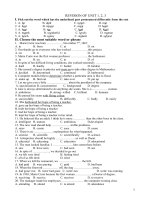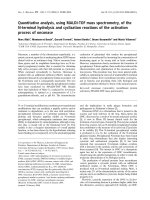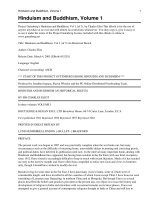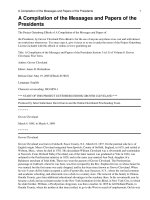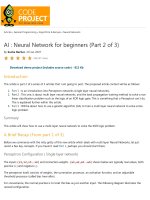Organocatalytic reactions of 3 hydroxy 2 pyrone and n arylsulfonyl 3 hydroxy 2 pyridone 2
Bạn đang xem bản rút gọn của tài liệu. Xem và tải ngay bản đầy đủ của tài liệu tại đây (370.9 KB, 31 trang )
Chapter 2
11
Chapter 2
Reactions of 3-hydroxy-2-pyrone
Chapter 2
12
2.1 3-Hydroxy-2-pyrone
3-Hydroxy-2-pyrone 1 is a compound that can be synthesized from the pyrolysis
of mucic acid in the presence of potassium dihydrogen phosphate and phosphorous
pentoxide (Scheme 2.1).
1
A mixture of products is obtained and by tuning the pH of the
mixture carefully, extraction can be done to singly extract the pyrone as a clean product
that is suitable for carrying out reactions. Ether is used as a solvent to extract the product
into the organic phase using a continuous extraction process.
Scheme 2.1 Synthesis of 1 from mucic acid.
Corey et al. had used 1 as a vinylketene equivalent that reacted like a diene in the
Diels-Alder process (Figure 2.1).
2
Figure 2.1 3-Hydroxy-2-pyrone 1 and vinylketene.
Under high temperature conditions, DA reactions can proceed smoothly followed
by decarboxylation reaction to remove CO
2
. In this way, the synthesis of a variety of
Chapter 2
13
dihydrophenolic compounds was realized. In the report, thermal conditions were required
for the reactions to take place. The dihydrophenolic products obtained contained one
chiral centre (Scheme 2.2). The asymmetric version was not evaluated in the
communication.
O
OH
O
CO
2
Me
CO
2
Me
CO
2
Me
CO
2
Me
+
benzene
toluene
toluene
115
o
C, 40hr
170
o
C, 22hr
200
o
C, 22hr
OH
CO
2
Me
CO
2
Me
OH
CO
2
Me
OH
CO
2
Me
Me
73% yield
56% yield
50% yield
1
Scheme 2.2 Reactions of 1 and activated olefins under reflux conditions to give
dihydrophenolic compounds.
Scheme 2.3 Reaction of 1 and 1,4-naphthoquinone.
Tsuboi’s group also used 1 to react with 1,4-naphthoquinone in refluxing PhMe in
the presence of NEt
3
(Scheme 2.3).
3
A Diels-Alder reaction is likely to be the first step
followed by the decarboxylation reaction under high temperature conditions. This is
Chapter 2
14
similar to the previous route reported by Corey (Scheme 2.2) except that a base (NEt
3
) is
used to facilitate the DA reaction. This reaction provided access to anthraquinone
derivatives.
Scheme 2.4 Reaction of 1 with chiral acrylates and its synthesis leading to (-)-eutipoxide.
The base-catalyzed DA reaction of 1 was also extended to the use of a chiral
acrylate as a dienophile (Scheme 2.4).
4
The chiral 2-oxazolidinone moiety was
responsible for inducing the asymmetry in the bicycloadduct. The product was obtained
in >70% yield. The chiral auxiliary could be transformed to a methyl ester group by
MeONa/MeOH. Subsequently, several steps were carried out successfully to yield the
final product. By switching the chiral centre on the 2-oxazolidinone group, the synthesis
of (+)-eutipoxide could also be achieved.
Chapter 2
15
2.2 2-Pyrones and derivatives
The majority of 2-pyrone reactions lies in its use as a diene in DA reactions. 1
was mentioned in the earlier part (Section 2.1) and that a small amount of base is usually
sufficient to catalyze its DA reaction with other dienophiles. This is an added advantage
as this provides a pathway whereby milder conditions can be used for the DA reactions.
However, a large part of 2-pyrone chemistry also involves compounds that contain no
hydroxyl group at the 3-position. To-date, much of the DA reactions of 2-pyrones (no
hydroxyl group at 3-position) require either high temperature or pressure for them to
work. There are no reports that demonstrate that a base is capable of catalyzing DA
reactions of such 2-pyrones. On the other hand, the products they produce are
significantly useful in the course of synthetic organic chemistry. It is thus worthwhile to
study these reactions and understand their mechanisms and to develop milder methods to
carry them out.
Scheme 2.5 Reaction of 2-pyrone with vinyl acrylate in a consecutive Diels-Alder
reaction.
Mark
Ó et. al performed a consecutive DA reaction using just the 2-pyrone and a
vinyl acrylate in a one-pot procedure (Scheme 2.5).
5
The conditions for the first DA
required a high pressure of 19kbar delivering a good yield of 95%. The high pressure will
Chapter 2
16
not affect the overall molecular structure. Subsequently, refluxing the product at a high
temperature of 200
o
C promotes the decarboxylation reaction removing a molecule of CO
2
giving a dihydrobenzene core. With the presence of a diene and an olefin in the same
molecule, an intramolecular DA reaction took place to yield the tricyclic compound as
shown.
The hydroxyl group of 1 was protected with a Me group and used as a diene.
1
In
this case, a base might not be able to catalyze a DA reaction as there is no hydroxyl group.
It was reacted with acetylene dicarboxylate under reflux conditions (Scheme 2.6).
Decarboxylation took place thereafter and an aromatic ring was formed. Like the
example shown earlier (Scheme 2.3), this is also a route to attain phenols and its
derivatives.
Scheme 2.6 Reaction of 3-methoxy-2-pyrone and acetylene type dienophiles under reflux
conditions.
Posner and coworkers have also shown that the presence of a bromine atom at the
3- or 5- position can increase the reactivity of 2-pyrones.
6-8
In a sealed vessel using
CH
2
Cl
2
as the solvent, 3-bromo-2-pyrone was reacted with electron-deficient olefins to
give the normal electron demand DA products (Scheme 2.7). Applying the same
conditions, it was also demonstrated that it can take part in inverse electron demand DA
Chapter 2
17
reactions (with ether type olefins) to give DA products as well. The unique ambiphilic
characteristic is not commonly found in a single diene but it is well embodied in this 2-
pyrone molecule. On the other hand, 5-bromo-2-pyrone was found to give cycloadducts
slowly under thermal conditions with both electron-poor and electron-rich
Scheme 2.7 Reaction of 3-bromo-2-pyrone and various dienophiles.
O
O
Br
R
+
25-100
o
C, 2-5d
83-100%
O
O
R
Br
R = CN, COMe, CO
2
H, OSiMePh
2
, p-Br-C
6
H
4
Scheme 2.8 Reaction of 5-bromo-2-pyrone and various dienophiles.
dienophiles. Despite the slow reaction rate, the bromo group at the 5-position has
increased the diene reactivity as a high reaction temperature is no longer required
(Scheme 2.8). Milder conditions can equally be applied for a reaction to take place.
Chapter 2
18
Posner also reported commercially available silica gel as another inexpensive
promoter for the DA reaction of the optically active pyrone lactate ester and benzyl vinyl
ether (Scheme 2.9).
9
The diastereoselectivity was 58% and the yield was 60% when it
was carried out in toluene at -30
o
C.
O
O
OO CO
2
Me
Me
O
Bn
+
SiO
2
,-30
o
C
PhMe
60% yield
d.e. 58%
O
O
O
CO
2
Me
O
Me
OBn
H
Scheme 2.9 Reaction of optically active pyrone lactate ester with benzyl vinyl ether using
silica gel as a promoter.
Scheme 2.10 Reaction of 3-carbomethoxy-2-pyrone with vinyl ethers in the presence of
lanthanide shift reagents.
This is another example that showed 2-pyrones can take part in inverse electron
demand DA reactions. 3-Carbomethoxy-2-pyrone can react with vinyl ethers to give DA
products in the presence of lanthanide shift reagents (Scheme 2.10).
10
The authors
reported that the use of strong Lewis acids can destroy the cycloadducts by gearing the
products towards decarboxylation. Strangely, Yb(OTf)
3
alone does not act as the catalyst
Chapter 2
19
but the addition of (R)-BINOL generates a new active catalyst that promotes the reactions
with moderate to good enantiomeric excess.
Corey also utilized a pyrone in the synthesis of the sesquiterpene (±)-occidentalol
(Scheme 2.11).
11
The initial step involved reacting the pyrone with 4-methyl-3-
cyclohexenone at 150
o
C under nitrogen for 24h. Decarboxylation occurred under the
reflux conditions to yield the basic decalin structure which upon further reactions gave
the racemic alcohol. The yield of the DA product was about 25-40%. Further
transformations led to the racemic product (±)-occidentalol.
O
O
CO
2
Me
O
+
150
o
C
24h
O
O
MeO
2
C
O
Me
- not detected in
reaction mixture
- decarboxylation occured
under reflux conditions
CO
2
Me
O
Me
Me
Me
OH
(±)-occidentalol
several steps
Scheme 2.11 Corey’s synthesis of (±)-occidentalol from 3-carbomethoxy-2-pyrone.
Previous examples had made used of either 3- or 5- substituted 2-pyrones for
reactions. However, Cho and coworkers had shown that even 3,5-disubstituted 2-pyrone
can be utilized for DA reaction (Scheme 2.12).
12
The yield for the cycloadduct was
acceptable and the product was used in the synthesis of (±)-joubertinamine.
Chapter 2
20
Scheme 2.12 Reaction of 3-aryl-5-bromo-2-pyrone with vinyl thioether.
Although 1 has a structure that has a few functional groups (hydroxyl group,
diene group and ester group), the major study lies in its use as a dienophile in Diels-Alder
reactions. Its structural similarity to 4-hydroxy coumarin and its existence as a readily
available enolate equivalent could have prompted its use as a donor in Michael or Aldol
type reactions.
O
OH
O
O O
OH
3-hydroxy-2-pyrone
4-hydroxycoumarin
a possible
point of attack
(alpha-attack)
point of attack
for Michael reaction
O O
OH
another point
of attack
(gamma-attack)
Figure 2.2 Comparing various points of attack (as a Michael donor) in 3-hydroxy-2-
pyrone and 4-hydroxycoumarin.
There are 2 possible sites of attack in 3-hydroxy-2-pyrone which are namely the
alpha site and the gamma site with respect to the alcohol (Figure 2.2). Deng reported that
1 can react with α,β-unsaturated ketones to give Michael products.
13
The products were
Chapter 2
21
observed to be an attack of 1 from its γ-position. N-sulfonyl-3-hydoxy-2-pyridone was
also observed to do Michael reactions with β-nitro styrenes. The details of this reaction
will be described in the following chapter.
J
Ørgensen used a simple chiral imidazolidine acid catalyst to catalyze the Michael
reaction between 4-hydroxycoumarin and α,β-unsaturated enones (Scheme 2.13).
14
Fairly
good yields were obtained and the enantioselectivity of the product was more than 80%.
This route could successfully provide a route to the anti-coagulant Warfarin.
Recrystalliztion using acetone/water mixture could increase the enantiomeric excess of
the Michael product to >95%.
Scheme 2.13 Organocatalytic Michael reaction of 4-hydroxycoumarin and α,β-
unsaturated enone.
Chapter 2
22
2.3 Synthesis of 3-hydroxy-2-pyrone derivatives
The study on the reactions of 1 can be impeded by the difficulty in developing the
substrate variants. The addition of different substituents on 3-hydroxy-2-pyrone remains
a difficult task for synthetic chemists. A route developed by Tsuboi requires a linear
multi-step synthesis to obtain the 4-halo-3-hydroxy-2-pyrone (Scheme 2.14).
15
The
substituent on the 6-position can be altered accordingly. The attachment of a halogen on
the 4-position facilitates coupling reactions to be done. However, the fact that several
steps are required for obtaining the 3-hydroxy-2-pyrones (6-substituted, 4-substituted, or
both) may actually slow down the research on the chemistry of their reactions.
Reagents and conditions: (i) t-BuOK (1.2 eq.), CHCl
2
CO
2
Et (1.0 eq.), THF (72% yield);
(ii) K
2
CO
3
, H
2
O-acetone; (iii) NaBH
4
, THF-MeOH, 0
o
C; (iv) DMP, PTSA (cat.), acetone,
rt, (71% yield, three steps), (v) DIBAL-H (1.5 eq.), Et
2
O, -78
o
C; (vi) t-BuOK,
CHCl
2
CO
2
Me (1.0 eq.), THF, (71% yield, two steps).
Scheme 2.14 Synthesis leading to 4-halo-3-hydroxy-2-pyrone.
Chapter 2
23
2.4 Asymmetric reactions of 3-hydroxy-2-pyrone
Scheme 2.15 DA reaction of 1 and 2c.
The reaction between 3-hydroxy-2-pyrone and N-benzyl maleimide can be
catalyzed by a small amount of base (Scheme 2.15). Preliminary studies included the
screening of the following oxazoline-containing compounds as catalysts for the reactions
(Figure 2.3). These bis-oxazolines (BOX) are commonly used for metal-catalyzed
reactions and had their roles as ligands binding to the metal centre.
16
To the best of our
knowledge, there was only one report describing that these ligands could catalyze the DA
reactions of anthrones and maleimides without the presence of any metal ions.
17
The
enantiomeric excess was moderate at about 70% but the yields were more than 90%.
To our surprise, they can also catalyze the DA reaction of 1 and N-substituted
maleimides. A 10 mol% loading of the catalyst is sufficient for the reaction to proceed to
completion. They were used as catalysts for the reaction of 1 and 2c, but the best result
was 40% enantiomeric excess which was obtained with A5.
Chapter 2
24
Figure 2.3 BOX ligands used as catalysts for the DA reactions of 1.
Our group has a major interest in using bicyclic guanidines as catalysts for
enantioselective reactions, particularly the C2-symmetric tert-butyl catalyst (Scheme
2.16).
18
Applying 10 mol% of the tert-butyl catalyst for the DA reaction of 1 and 2c, an
enantiomeric excess of 45% can be obtained for the cycloadduct.
Scheme 2.16 DA reaction catalyzed by C2-symmetric bicyclic guanidine catalyst.
Nakatani had demonstrated the use of cinchona alkaloids as catalysts in the DA
reaction between 1 and various dienophiles. Deng perfected the reaction with various
dienophiles by fine tuning the structures of the alkaloids used. With this in mind, we were
certain that a bifunctional catalyst containing a tertiary amine and a hydrogen bond donor
would be useful in the DA reactions of this class of dienes.
Chapter 2
25
Chiral pyrrolindinyl sulfonamides (CPS) 3a-d contain a pyrrolidine group (hydrogen-
bond acceptor) and a sulfonamide group (hydrogen-bond donor). They can be easily
synthesised from commercially available amino alcohols and they were shown to be effective
promoters in the tandem conjugate elimination-addition reactions of allylic bromides and
thiomalonates (Scheme 2.17).
19
Encouraged by this finding we tested these CPS (Figure 2.4)
as catalysts in the DA reactions of 1. They were found to be great catalysts for the Diels-
Alder reactions of 1 as well. Excellent yields were obtained and good to moderate
enantiomeric excess (up to 88%) were achieved (Table 2.1).
Scheme 2.17 S
N
2’ reaction of cyclic allylic bromides and dithiomalonates promoted by
CPS 3a-d.
Figure 2.4 Structures of chiral pyrrolidinyl sulphonamides (CPS) 3a-d.
The DA reaction completed in most common solvents such as CH
2
Cl
2
and THF. Polar
solvents such as methanol and acetonitrile were found to decrease the
Chapter 2
26
Table 2.1 Screening of catalysts and solvents for the Diels Alder reaction of 1 and N-
substituted maleimides.
Entry CPS Solvent R Temp/
o
C Yield/%
a
ee/%
b
1
3a
CH
2
Cl
2
Ph rt 90 65(2)
2
3b
CH
2
Cl
2
Ph rt 85 32(0)
3
3c
CH
2
Cl
2
Ph rt 88 11(7)
4
3d
CH
2
Cl
2
Ph rt 91 40(0)
5
3a
PhMe Ph rt 92 50(5)
6
3a
THF Ph rt 86 26(0)
7
3a
CHCl
3
Ph rt 82 33(9)
8
3a
Et
2
O Ph rt 80 45(0)
9
3a
MeOH Ph rt 81 3(0)
10
3a
MeCN Ph rt 82 5(0)
11
3a
CH
2
Cl
2
Ph -20 80 81(20)
12
3a
CH
2
Cl
2
Ph -40 82 85(15)
13
3a
CH
2
Cl
2
Ph -40 81 88(28)
14
3a
CH
2
Cl
2
Cy -40 82 88(20)
15
3a
CH
2
Cl
2
Bn -40 83 87(20)
a
Isolated yield.
b
Chiral HPLC.
Chapter 2
27
enantioselectivity drastically (Table 2.1, entries 9 & 10). The best results were obtained
when CH
2
Cl
2
was used as the solvent. Other N-substituted maleimides were synthesised
and they gave similar enantiomeric excess (Table 2.1, entries 14 & 15). The best result was
obtained when the benzyl catalyst 3a was used. By lowering the temperature, the
enantiomeric excess could be improved as can be seen from entries 11-15. This particular
reaction is unique because the major isomer produced is the exo isomer compared to most
other reports where endo product is the major isomer.
NO
O
O
O
OH
O
+
O
O
HO
O
10 mol%
3b
CH
2
Cl
2
,rt
72h
N
O
O
70% yield
70% ee
1
Scheme 2.18 DA reaction of 1 and terminal olefin catalyzed by 3b.
To demonstrate that the system is not limited to cyclic dienophiles, a terminal
olefin was also used in the DA reaction with 1 (Scheme 2.18). A slower reaction rate was
observed but a steady conversion of the product was obtained. The enantiomeric excess
was about 70%. However, the reaction rate was rather slow (72h) such that optimization
of the reaction condition by lowering the temperature was not carried out.
Chapter 2
28
Scheme 2.19 DA reaction of 1 and 2d.
The amino indanol which was developed for the asymmetric DA reactions of N-
sulfonyl-3-hydroxy-2-pyridone (more about this reaction would be discussed in the next
chapter), was also found to be a suitable catalyst for the Diels-Alder reaction of 3-
hydroxy-2-pyrone and N-mesityl maleimide (Scheme 2.19). The yield was about 95%
with an endo:exo ratio of about 3:1. The major product had a higher enantioselectivity of
90%. With this, it was demonstrated that several catalysts developed in our lab were able
to catalyze the reaction of 3-hydroxy-2-pyrone and various dienophiles giving moderate
to high enantioselectivities.
The enantiomer of product 5a was also used in the synthesis of the key
intermediate of an SP antagonist RPR107880 (Figure 2.5).
20
Substance P (SP) is a small
peptide classified in the tachykinine family and it behaves like a neurotransmitter. The
protecting group used in this synthesis was benzyl instead of the mesityl (2,4,6-C
6
H
2
)
group. In this report, the authors used quinine as the catalyst and the best enantiomeric
excess obtained for the cycloadduct was 63%. The method they used for obtaining the
optically pure product was by recrystallization of the cycloadduct.
Chapter 2
29
O
O
OH
N
O
O
Bn
N
O
Bn
multi-step
transformation
transformations
N
OH
O
OMe
OMe
intermediate
Diels-Alder product
from 3-hydroxy-2-pyrone
and N-benzyl maleimide
RPR 107880
Figure 2.5 DA product of 1 and N-benzyl maleimide leading to the synthesis of RPR
107880.
Chapter 2
30
2.5 Vinylogous Aldol Reaction (VAR) of 3-hydroxy-2-pyrone
3-Hydroxy-2-pyrone is known to take part in Diels-Alder reactions with dienophiles.
21
In
an attempt to develop hetero-Diels-Alder reactions using 3-hydroxy-2-pyrone as a diene
and aromatic aldehydes as dienophiles, it was discovered that a vinylogous aldol reaction
takes place instead.
Scheme 2.20 Investigation of 1 with aldehydes to yield hetero-DA product.
VAR is a powerful bond-forming reaction and has been adopted in the synthesis of
several natural products.
22
There are several examples whereby Lewis bases and Lewis
acids are utilised as catalysts or promoters in VARs.
23
However, the employment of a
Bronsted base as a catalyst is rarer.
In a VAR, there are two possible positions of attack, namely the α-addition and the γ-
addition (Scheme 2.21).
24
The ratio of products formed is dependent on the type of
dienolate and the reaction conditions.
25
As such, there is a need to examine the reasons of
attack at each position, as well as to optimize the reaction conditions in order to obtain the
desired aldol product.
Chapter 2
31
O
OH
O
Ar
O
H
+
O
OH
O
Ar OH
O
OH
O
Ar
OH
alpha-addition
gamma-addition
1
Scheme 2.21 Alpha and gamma attacks of pyrone on the aldehyde.
Preliminary work for the type of base and the catalyst loadings were carried out using 3-
hydroxy-2-pyrone with 4-cyanobenzaldehyde (Table 2.2). When the reaction was first
carried out with 10 mol% triethylamine (TEA), the reaction was very slow and failed to
complete after 4 days. Even when the catalyst loading was increased to 50 mol%, the
reaction took 18 hours to complete. The reaction rate for methylpyrrolidine was similar to
that of TEA. This was probably due to the fact these two Br
Ønsted bases are both tertiary
amines and have similar pK
a
values. One important observation is that pyrrolidine, a
secondary amine does not catalyze the reaction. This indicated that the VAR likely does not
proceed via an enamine intermediate.
Figure 2.6 Organic bases used for VAR
Chapter 2
32
Table 2.2 Reaction between 1 and 4-cyanobenzaldehyde using different
catalysts.
Entry Base Loading/% Time/hr Conversion/%
a
1 TEA 10 96 80
2 TEA 50 18 95
3 TBD 10 48 95
4 TBD 15 30 95
5 TBD 30 12 95
6 Pyrrolidine 15 96 trace
7 N-methyl pyrrolidine 15 96 90
All entries employed 1 eq. of 1, 4 eq. of 4-cyano benzaldehyde and 0.5 ml of
solvent.
a
Conversion determined using
1
H NMR of crude reaction mixture.
The reaction was greatly improved when 1,5,7-triazabicyclo[4.4.0] dec-5-ene (TBD) was
employed as the catalyst in the reaction.
26
It has been shown that TBD is able to promote
reactions such as the Wittig reaction,
27
the Henry reaction
28
and the addition of phosphites
to carbonyl compounds
28
and the addition of azoles to α,β –unsaturated nitriles and esters.
29
The reaction with 10 mol% TBD achieved 95 % conversion within 48 hours.
Chapter 2
33
A slight increase of catalyst loading to 15 mol% allowed a reasonable rate of completion in
30 hours. Though a higher catalyst loading of TBD further improved the reaction rate, 15
mol% was the loading of choice.
The solvent screen was carried out and the general trend that more polar solvents
gave a faster reaction rate was observed. Reaction in non-polar solvents such as toluene
failed to complete after a long reaction time. When the reaction was carried out in
chlorinated solvents (CH
2
Cl
2
, CHCl
3
and 1,2-DCE) or THF, generally high conversions to
the products were observed after about 48h of reaction. Using a polar protic solvent such as
MeOH, the reaction rate was simliar to when CH
2
Cl
2
was used as the solvent, reaching a
conversion of 80% after two days. Carrying out the reaction in polar aprotic solvent such as
MeCN took 19 hours to complete. The fastest reaction rates were obtained when polar
aprotic solvents such as DMSO and DMF were used. The reactions took only 30 min to
complete.
Chapter 2
34
Table 2.3 Reaction between 1 and 4-cyanobenzaldehyde using different solvents.
O
OH
O
NC
O
H
catalytic base
solvent, rt
+
O
OH
O
OH
NC
1
VAP 1
Entry Solvent Time/hr Conversion
1 PhMe 96 50
2 THF 48 99
3 CHCl
3
48 95
4 CH
2
Cl
2
48 80
5 (CH
2
Cl)
2
30 95
6 MeCN 19 98
7 MeOH 48 80
8 DMF 0.5 99
9 DMSO 0.5 99
All entries employed 1 eq. of 1, 4 eq. of 4-cyano benzaldehyde, 0.15 eq. of TBD and 0.5
ml of solvent.
Chapter 2
35
With optimized conditions, the VARs of 3-hydroxy-2-pyrone were attempted with different
aldehydes. Aromatic aldehydes with various substituents were used, as well as aliphatic
aldehydes.
The most reactive aldehydes were the electron deficient aldehydes, giving the
fastest rates of reaction and relatively good yields of the aldol adducts. This was expected
as electron-withdrawing substituents can activate the carbonyl carbon towards attack by a
nucleophile.
The VARs with para-halogenated benzaldehydes worked well, even though
halogens do not demonstrate a strong electron withdrawing effect. All these reactions
completed within 18 hours and gave relatively good yields. Only the gamma addition
adducts were observed.
The VAR with aromatic aldehyde with an electron donating group could work well
too as in the case of 4-methylbenzaldehyde (Table 2.4, entry 6). However, as electron
donating substituents deactivate the carbonyl carbon towards nucleophilic addition, it was
of no surprise that this aldehyde is less reactive. The reaction proceeded slowly and did not
complete. A yield of 46% was obtained after 48 hours.
An aliphatic aldehyde initially tested (acetaldehyde) is a liquid with a low boiling
point (b.p. 20
o
C). It was difficult to assess if the aldehyde evaporated when used in small
amounts. When i-butyl aldehyde was used for the VAR, a slower reaction rate was
observed (conditions applied were those when aromatic aldehydes were used). As such, the


